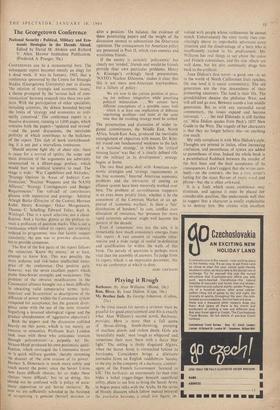The Georgetown Conference
National Security : Political, Military and Eco- nomic Strategies in the Decade Ahead. Edited by David M. Abshire and Richard V. Allen. Hoover Institution Publication. (Frederick A. Praeger, 70s.) CONFERENCES can be a monumental bore. The subsequent report becomes merely an elegy for a dead week. It was in January, 1963, that a conference sponsored by the Centre for Strategic Studies (Georgetown University) met to discuss `the relation of strategic and economic issues,' a theme prompted by the 'serious lack of com- munication' between research into these two sub- jects. With the participation of other specialists, including scientists, the debate bounded beyond the limits of 'strategy and economics as ordi- narily conceived.' The conference report is a massive document, running to 1,030 pages, which contains both the papers—`updated and revised' —and the panel discussions, the inevitable prolixity of which contributes to the bulkiness of the report. This slab of book notwithstand- ing, it is not just a marvellous tombstone.
Should anyone fight shy of sheer size, there is cause for a revival of spirits; the scope and main direction of the arguments are admirably summarised in a fifteen-page preface, which would hurt no political scientist to read. The range is wide: `War Capabilities and Attitudes,' 'Strategy Options in Areas of indirect Con- frontation,' Nuclear Weapons and the NATO Alliance,' 'Strategy Contingencies and. Budget Requirements.' The roll-call of contributors glistens with reputation and prestige : Admiral Arleigh Burke (Director of the Centre), Herman Kahn, Henry Kissinger, Oskar Morgenstern, Thomas C. Schelling, Edward Teller, Karl A. Wittfogel. That is a quick selection, not a classi- fication. And a further glance at the preface re- veals a profusion of question marks. This is not a • conference which tidied its report, nor evidently ordered its programme, into that faintly suspect unanimity; the aim was to provoke discussion, not to provide consensus.
The first of the five parts of the report follows the injunction 'Know thy enemy,' or . at least, attempt to know him. This was possibly the most arduous and risk-laden intellectual enter- prise of the conference. Qne positive gain, however, was the seven excellent papers which probe Sino-Soviet strengths and weaknesses. The problem of the obvious modifications in the Communist alliance brought out a basic difficulty In obtaining valid comparative terms; 'poly- centrism' and 'bi-centrism' as descriptions of the diffusion of power within the Communist system competed for acceptance, but the greatest diver- gence came with the use of the term 'erosion' (signifying a lessened ideological vigour and the gradual abandonment of 'aggressive objectives').
Both the papers and the discussion collided heavily on this point, which is not merely an exercise in semantics. Professor Kurt London took issue with those who anticipate 'erosion through polycentrism'—a palpable hit. Dr. Sfrausz-Hupe produced his own pessimistic quali- fication, which envisaged the Communist resort to 'a quick military gamble,' thereby stemming the disaster of 'the slow erosion of its power.' Herbert S. Dinerstein is much more subtle and much nearer the point; since the Soviet Union now faces difficult choices, let us make these choices 'more difficult,' but in so doing, this should not be confused with 'a policy of auto- matic opposition to any Soviet initiative.' By now we are sufficiently schooled in the business 01 recognising 'a genuine [Soviet] decision to alter a position.' On balance, the evidence of these penetrating papers and the weight of the discussion seemed to substantiate the Dinerstein optimism. The consequences for American policy are presented in Part 11, which eyes enemies and scrutinises friends.
If the enemy is certainly 'polycentric' but clearly not 'eroded,' friends and would-be friends provide thier own particular problems. Henry A. Kissinger's strikingly lucid presentation, 'NATO's Nuclear Dilemma,' makes it clear that this is not mere non-American waywardness, but a failure of policy: We are now in the curious position of press- ing for military integration while practising political -bilateralism. . . . We cannot have different conceptions of a possible cams belli --which is at least one implication of different negotiating positions—and insist at the same time that the resulting strategy must be unified.
The presentation and discussion of wider re- gional commitments, the Middle East, North Africa, South-East Asia, produced the inevitable entanglement of objectives with means. Dr. Kint- ner traced one fundamental weakness to the lack of a 'national strategy,' in which the 'critical missing factor' was that of 'a clearly defined role for the militark in its development'; strategy begins at home.
The two final parts deal with American eco- nomic strategies and 'strategy requirements in the free economy.' Internal American economic problems and the intricacies of costing an alliance system have been massively worked over here. The problem of co-ordination reappears in an even more prickly form, whether it be the assessment of the Common. Market or an ap- praisal of 'economic warfare.' Is there a 'fair' distribution of burdens? In sum, conflict over allocation of resources, but 'pressure for more rapid economic advance' might well become the pattern of the decade.
Even if 'consensus' was not the aim, it is remarkable,how much consistency emerges from this report. A vast amount of valuable infor- mation and a wide range of useful re-definition and qualification lie within the walls of this book. The parade of questions is perhaps more vital than the assembly of answers. To judge from its report, which is an impressive document, this was no conference at which to doze.
JOHN ERICKSoN


































 Previous page
Previous page